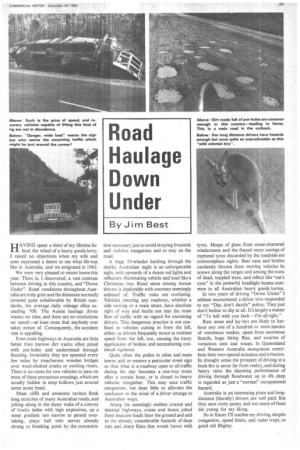Road Haulage Down Under
Page 41

If you've noticed an error in this article please click here to report it so we can fix it.
By Jim Best
HAVING spent a third of my lifetime behind the wheel of a heavy goods lorry, I raised no objections when my wife and sons expressed a desire to see what life was like in Australia, and we emigrated in 1962.
We were very pleased to return home this year. There is, I discovered, a vast contrast between driving in this country, and "Down Under". Road conditions throughout Australia are truly grim and the distances normally covered quite unbelievable by British standards, the average daily mileage often exceeding 700. The Aussie haulage driver wastes no time, and there are no restrictions on speed—at least none that anybody ever takes notice of. Consequently, the accident rate is appalling.
Even main highways in Australia are little better than narrow dirt tracks often pitted with pot-holes and undermined through flooding. Invariably they are spanned every few miles by treacherous wooden bridges over weed-choked creeks or swirling rivers. There is no room for two vehicles to pass on most of these precarious crossings, which are usually hidden in deep hollows just around some acute bend.
Sheer cliffs and awesome ravines flank long stretches of many Australian roads, and jolting along in the dusty wake of a convoy of trucks laden with high explosives, up a steep gradient too narrow to permit overtaking, plays hell with nerves already strung to breaking point by the concentra tion necessary just to avoid straying livestock and reckless kangaroos and to stay on the road.
A huge 10-wheeler hurtling through the murky Australian night is an unforgettable sight, with upwards of a dozen red lights and reflectors illuminating vehicle and load like a Christmas tree. Road sense among Aussie drivers is deplorable with courtesy seemingly unheard of. Traffic rules are confusing. Vehicles entering any roadway, whether a side turning or a main street, have absolute right of way and hurtle out into the main flow of traffic with no regard for oncoming drivers. This dangerous practice is not confined to vehicles cutting in from the left, either, as drivers frequently motor at reckless speed from the left, too, causing the hasty application of brakes and necessitating continual vigilance.
Quite often the police in cities and main towns add or remove a particular street sign so that what is a roadway open to all traffic during the day becomes a one-way street after a certain hour, or is closed to heavy vehicles altogether. This may ease traffic congestion, but does little to alleviate the confusion in the mind of a driver strange to Australian ways.
Along the seemingly endless coastal and internal highways, crates and boxes jolted from insecure loads litter the ground and add to the already considerable hazards of deep ruts and sharp flints that wreak havoc with tyres. Heaps of glass from stone-shattered windscreens and the frayed outer casings of ruptured tyres discarded by the roadside are commonplace sights. Beer cans and bottles carelessly thrown from moving vehicles lie strewn along the verges and among the roots of dead, toppled trees, and reflect like "cat's eyes" in the powerful headlight beams common to all Australian heavy goods lorries.
In two years of driving "Down Under" I seldom encountered a driver who responded to my "Dip, don't dazzle" policy. They just don't bother to dip at all. It's largely a matter of "To hell with you Jack—I'm all right."
Rest areas and lay-bys are likely to harbour any one of a hundred or more species of venomous 'snakes, apart from enormous lizards, huge biting flies, and swarms of voracious ants and wasps. In Queensland and Western Australia mosquitoes contribute their own special nuisance and irritation. In drought areas the prospect of driving in a bush-fire is never far from reality, and during heavy rains the alarming performance of driving through floodwater up to 4ft. deep is regarded as just a "normal" occupational hazard.
Australia is an interesting place and longdistance (literally) drivers are well paid. But they earn evety penny and too many of them die young for my liking.
So in future I'll confine my driving, despite congestion, speed limits, and radar traps, to good old Blighty.




















































































